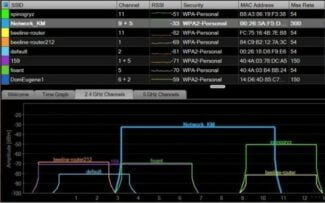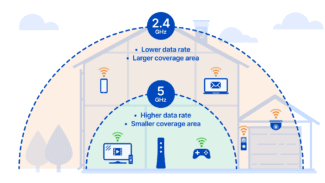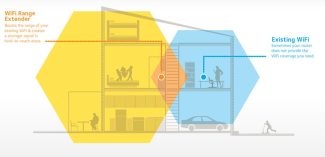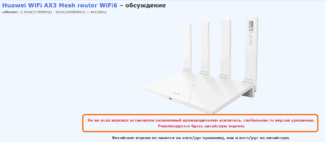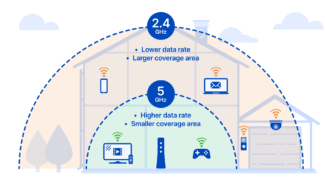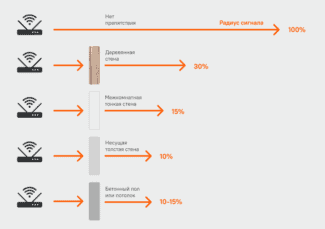A less expensive way is to replace your router's regular antenna with a high gain antenna or a directional antenna.
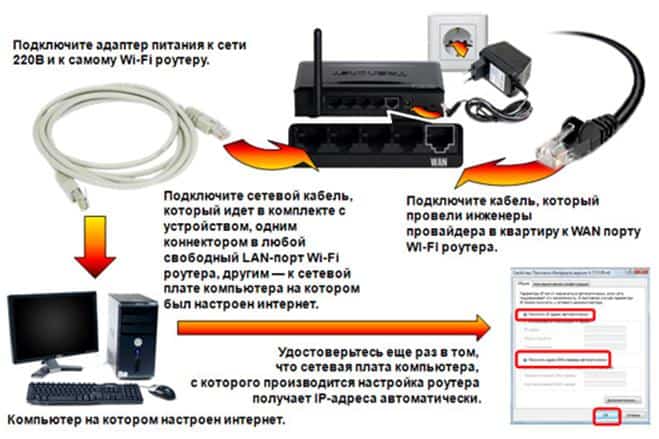
Powerful wifi router
The range of a wifi router depends on the type of router or access point used. Factors that determine the range of the router (access point) are:
- total transmitter power;
- The type of 802.11 protocol used;
- The length and attenuation of the cables connected to the antenna;
- Obstacles and interference in the signal path in a given room;
- the gain of the router's antennas.
Range wifi router standard 802.11g, with the regular antenna (gain about 2dBi) is approximately 150m in the open and indoors – 50 m. But brick walls and metal structures can reduce this range by 25% or more. 802.11a uses higher frequencies than 802.11b/g, so it is more sensitive to various obstacles. In addition, the range of 802.11b or 802.11g Wi-Fi networks is greatly affected by interference from microwave ovens. Tree foliage is also a strong obstacle because it contains water, which absorbs the microwave radiation of the band in use. For example, heavy rain weakens the signal in the 2.4GHz band to 0.05 dB/km, thick fog – 0.02 dB/km, and the forest (dense foliage, branches) – up to 0.5 dB/meter.
Choosing a Wi-Fi router, the range can be roughly calculated using a special calculator, which is slightly below, it is designed for D-Link equipment, but the formulas and methodology used there will be suitable for any other.
If creating a radio bridge between two networks, it must be taken into account that the space around the straight line drawn from the receiver to the transmitter must be free of
absorbing and reflecting obstacles in a radius equal to 0.6 of the radius of the first Fresnel zone. The size of this zone can be calculated by the following formula:

Powerful Wi-Fi router
If you choose a powerful router, its range and reception quality should satisfy your requirements.
The power of a wifi router is largely determined by the power of the signal boosters in it.
A powerful router on the Realtek 8187L chipset has not only a high power of 1 watt, but also large-scale support. Drivers for this chipset are supported by all operating systems. If you use an external optional antenna, the distance can reach up to 5 km.
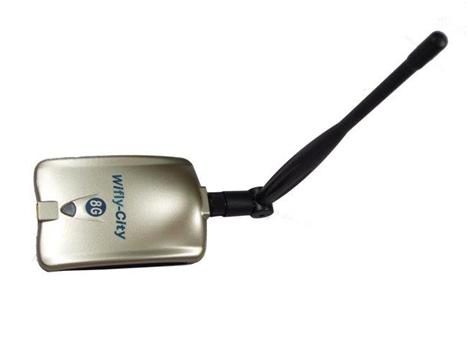
Rasprostranenye brands Alfa, NEtsys, Senao EnGenius EUB Ext High-Power, Wifly city 8G , 20G , AIRLIVE, G-Sky GS-27USB-50, KASENS.
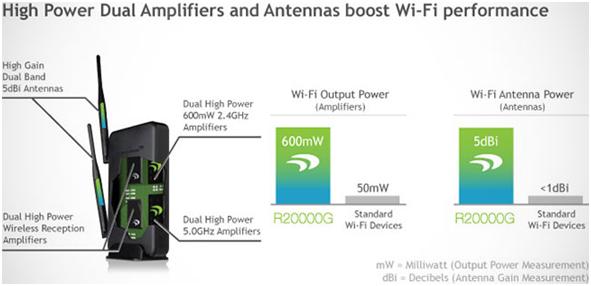
Amped Wireless has released its most powerful router, the R20000G High Power Wireless-N, which features 600 mW of 2.4 GHz signal amplification.
The R20000G is capable of two networks: 5000 MHz and 2400 MHz. Router provides indoor coverage up to 930 square meters. Two powerful antennas with 5 dB/inch of gain are connected to the router, but they can be replaced with more powerful ones.
How to calculate the effective distance
Let's say the wireless connection works when the distance between the access point and the smartphone is N meters with no obstacles in the path of the signal. A table from which you can find out how many times the intensity decreases when passing this or that obstacle, there are several sites (such as ZyXEL). At the same time, it is known that reducing the intensity by 2 times (by 3 decibels) is equivalent to reducing the effective distance N by the root of two times. It's simple – the square of the distance is inversely proportional to the intensity.
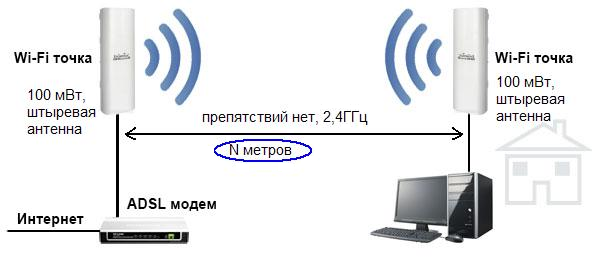
When the signal passes a glass window, the intensity decreases by just 3 dB, which means that the effective distance decreases by a root of two times. Using this technique, you can calculate at what distance the Wi-Fi connection will still work in a given situation:
- Glass window – reduces intensity by 3 dB (2x)
- Tinted window – 6 dB (4 times)
- Wood wall – 9 dB (8 times)
- Interior panel wall, concrete floor – 15-20 dB (32 times or more).
The coefficient by which you divide the distance value is equal to the square root of the intensity reduction factor. Consider an example.
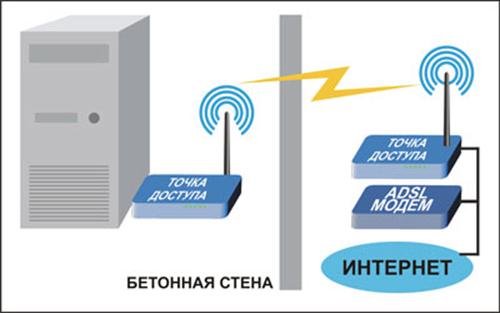
Suppose that N is 400 m. Now we "put" one panel wall and one wall of wood between the router and the smartphone. Adding up the decibels (15+9 dB), we get 24 decibels. On a logarithmic scale, it is 24, and on a linear scale, it is equivalent to a 251-fold decrease in intensity. Now, calculate what the root of 251 is (it's 15.84). Divide 400 meters by 16, and you get 25 meters. As you can see, it is simple and seems to be true.
Effective distance without obstacles
The reader is probably wondering what is the value of N with no obstacles at all, depending on the choice of Wi-Fi range. If the router's transmitter power is 40 mW, and its antenna "amplifies" the signal in the horizontal plane by 3 dB (it's multi-link), then according to ZyXEL, the N value is 400 meters. See: the router has a less powerful transmitter than the smartphone, but it uses a multilink antenna. Bottom line: the connection between two Wi-Fi devices with a transmitter power of 100 mW and an ordinary pin antenna is confidently maintained at a distance of up to 400 m. Here we were talking about the 2.4 GHz band.
Results of practical observations
Let's evaluate the "breakthrough capability" of Wi-Fi in practice. For this purpose we will take a set of access points supporting communication in the range of 2.4 GHz: this is TEW-411BRP+ from TRENDnet, DWL-2100AP from D-Link, and USR 805450 from US Robotics. As the subscriber device we will use a smartphone with 100 mW transmitter power. At the access points will install regular antennas, and they will be located on the fifth floor of a panel building.
Maximum range, good reception
There is no Wi-Fi network on the third floor of the building where our equipment is installed. The wave overcame 2 reinforced concrete slabs, so we lost 30 dB and that's it, no connection. In fact, consider that 35 decibels are lost when going through two slabs. You have to add the attenuation depending on the length of the distance, then we get about 36-38 dB. So this is the attenuation for 100 milliwatts that is critical.
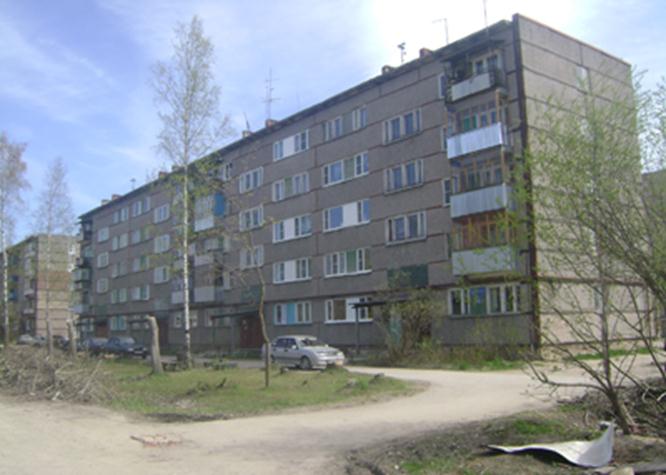
Try to catch the signal on the street. At a distance of 150-180 meters you can notice the presence of the network, but this is true if you are opposite the window of the room where the equipment is installed. And the connection remains stable at a distance of 100 meters. As you can see, the theory corresponds to practice with a sufficient level of reliability. For reliability, theoretically obtained result (one window -> 200 meters) is better to divide by 2.
What not to do
It is clear to everybody that it is hardly worth increasing the power of one of the transmitters when the second, i.e. the "subscriber" transmitter, remains unchanged. The same can be said of the use of antennas which allow increasing the intensity of the wave, but narrowing the diagram. However, the use of sectorial and multi-link antennas will still be effective, and here's why. Routers and other radio wave emitters may not only be in your apartment, but also the neighbors, etc. And by narrowing the capture sector, you can rid your router of extraneous RF noise.
Read More:
